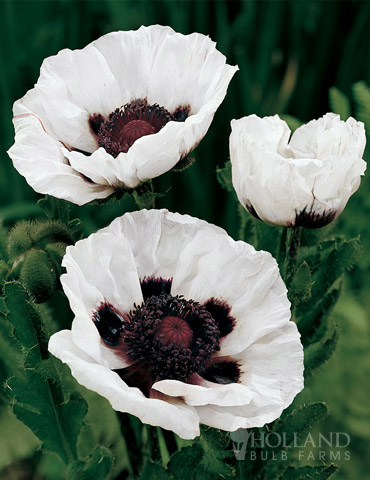Their bold, eye-catching blooms will command your attention in late spring. Try to look away. You can’t. The large, ruffled, bold blooms dominate the gardenscape. What are they? Oriental Poppies. These hardy spring perennials demand attention with papery petals, textured leaves, and vibrant colors. They also demand attention to how, when, and where they are planted. Therefore, if planting Oriental Poppies this fall is in your plans read more in our complete guide to planting Oriental Poppies.
Planting Oriental Poppies
Where to Plant Oriental Poppies
Site location when planting Oriental Poppies is critical. Once they are established in the garden they do not like to be moved and don’t tolerate transplanting well. Therefore, select a location where they will be happy to live for the long term. This location should receive full to part sun. 6-8+ hours of direct sun per day is the best sun exposure for Oriental Poppies.
Well-drained soil is the most important factor for successfully growing Oriental Poppies. The soil should drain well and not hold moisture, this is especially critical during the winter months. Before planting assess the site to see if the soil holds water. If it is suspected that drainage could be improved before planting mix in composted manure, and planting mix to the planting location. This will help to ensure the roots aren’t sitting in wet soil which is detrimental to their survival.
Best Time to Plant Oriental Poppies
Bare root poppies are available for planting in the spring and the fall planting season. The preferred planting season for Oriental Poppies is in the fall. Plant the roots at least 6 weeks before the ground freezes for winter so they may get established before winter dormancy.
How to Plant Oriental Poppies from Bare Root
When the dormant roots of Oriental Poppies arrive they will be in a package of peat moss. Take the roots out of the package and inspect the roots to make sure they are firm. If any soft or mushy spots are seen remove these parts. The roots should be held together by the crown of the plant at the center. The planting hole should be as wide as the roots can be spread out. Plant the crown of the root just below the surface of the soil. If the root is planted too low it will rot. Planting the root too high will cause it to dry out.
What to Plant With Oriental Poppies
Late spring blooming perennials and bulbs are the best companion plants for Oriental Poppies. Allium, Bearded Iris, and Columbine are some of the best late-spring bloomers to plant with poppies. Find more detailed suggestions of allium that look good when planted with Oriental Poppies in this helpful article. Since Oriental Poppies go dormant shortly after blooming consider planting perennials like cranesbill or catmint that will fill their spot in the garden during dormancy.
Pay Attention to the Poppies
They stand out in the garden. When in bloom they are the shining stars in late spring and can distract from other garden plants. Therefore, site location is important with poppies, for the visual impact but also the success of their growth. If they are planted in the correct location they will be a long-lived perennial in late spring for many years, so please take care and pay attention to the poppies.



